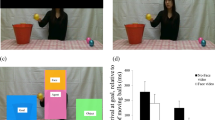Abstract
In the director task (DT), participants are instructed to move objects within a grid of shelves while ignoring those objects that cannot be seen by a human figure, the “director,” located beyond the shelves. It is widely assumed that, since they are explicitly instructed to do, participants use mentalizing in this communicative task; they represent what the director can see, and therefore the DT provides important information about how and when mentalizing is used in adult life. We tested this view against a “submentalizing” hypothesis suggesting that DT performance depends on object-centered spatial coding, without mentalizing. As predicted by the submentalizing account, we found that DT performance was unchanged when the director was replaced by an inanimate object, a camera, and that participants with autism spectrum disorders were unimpaired, relative to matched control participants, in both the director and camera conditions. In combination with recent critical analyses of “implicit mentalizing,” these findings support the view that adults use mentalizing sparingly in psychological experiments and in everyday life.


Similar content being viewed by others
References
Aichhorn, M., Perner, J., Kronbichler, M., Staffen, W., & Ladurner, G. (2006). Do visual perspective tasks need theory of mind? NeuroImage, 30, 1059–1068. doi:10.1016/j.neuroimage.2005.10.026
Apperly, I. A., Carroll, D. J., Samson, D., Humphreys, G. W., Qureshi, A., & Moffitt, G. (2010). Why are there limits on theory of mind use? Evidence from adults’ ability to follow instructions from an ignorant speaker. Quarterly Journal of Experimental Psychology, 63, 1201–1217. doi:10.1080/17470210903281582
Baron-Cohen, S., Wheelwright, S., Skinner, R., Martin, J., & Clubley, E. (2001). The Autism-Spectrum Quotient (AQ): Evidence from Asperger syndrome/high-functioning autism, males and females, scientists and mathematicians. Journal of Autism and Developmental Disorders, 31, 5–17. doi:10.1023/A:1005653411471
Begeer, S., Malle, B. F., Nieuwland, M. S., & Keysar, B. (2010). Using theory of mind to represent and take part in social interactions: Comparing individuals with high-functioning autism and typically developing controls. European Journal of Developmental Psychology, 7, 104–122. doi:10.1080/17405620903024263
Dolk, T., Hommel, B., Colzato, L. S., Schütz-Bosbacck, S., Prinz, W., & Liepelt, R. (2011). How “social” is the social Simon effect? Frontiers in Psychology, 2, 84. doi:10.3389/fpsyg.2011.00084
Dumontheil, I., Apperly, I. A., & Blakemore, S.-J. (2010). Online usage of theory of mind continues to develop in late adolescence. Developmental Science, 13, 331–338. doi:10.1111/j.1467-7687.2009.00888.x
Dumontheil, I., Küster, O., Apperly, I. A., & Blakemore, S.-J. (2010). Taking perspective into account in a communicative task. NeuroImage, 52, 1574–1583. doi:10.1016/j.neuroimage.2010.05.056
Frith, U. (2012). Why we need cognitive explanations of autism. Quarterly Journal of Experimental Psychology, 65, 2073–2092. doi:10.1080/17470218.2012.697178
Happé, F. G. E. (1994). An advanced test of theory of mind: Understanding of story characters’ thoughts and feelings by able autistic, mentally handicapped, and normal children and adults. Journal of Autism and Developmental Disorders, 24, 129–154. doi:10.1007/BF02172093
Heyes, C. M. (2014). Submentalizing: I’m not really reading your mind. Perspectives on Psychological Science, 9, 131–143. doi:10.1177/1745691613518076
Heyes, C. M., & Frith, C. D. (2014). The cultural evolution of mind reading. Science, 344, 1243091. doi:10.1126/science.1243091
Keysar, B., Barr, D. J., Balin, J. A., & Brauner, J. S. (2000). Taking perspective in conversation: The role of mutual knowledge in comprehension. Psychological Science, 11, 32–38. doi:10.1111/1467-9280.00211
Keysar, B., Lin, S., & Barr, D. J. (2003). Limits on theory of mind use in adults. Cognition, 89, 25–41. doi:10.1016/S0010-0277(03)00064-7
Lord, C., Risi, S., Lambrecht, L., Cook, E. H., Jr., Leventhal, B. L., DiLavore, P. C., . . . Rutter, M. (2000). The Autism Diagnostic Observation Schedule-Generic: A standard measure of social and communication deficits associated with the spectrum of autism. Journal of Autism and Developmental Disorders, 30, 205–223. doi:10.1023/A:1005592401947
Ridderinkhof, K. R., Ullsperger, M., Crone, E. A., & Nieuwenhuis, S. (2004). The role of the medial frontal cortex in cognitive control. Science, 306, 443–447. doi:10.1126/science.1100301
Samson, D., Apperly, I. A., Braithwaite, J. J., Andrews, B. J., & Bodley Scott, S. E. (2010). Seeing it their way: Evidence for rapid and involuntary computation of what other people see. Journal of Experimental Psychology: Human Perception and Performance, 36, 1255–1266. doi:10.1037/a0018729
Santiesteban, I., Catmur, C., Coughlan Hopkins, S., Bird, G., & Heyes, C. (2014). Avatars and arrows: Implicit mentalizing or domain-general processing? Journal of Experimental Psychology: Human Perception and Performance, 40, 929–937. doi:10.1037/a0035175
Schilbach, L., Timmermans, B., Reddy, V., Costall, A., Bente, G., Schlicht, T., & Vogeley, K. (2013). Toward a second-person neuroscience. Behavioral and Brain Sciences, 36, 393–414. doi:10.1017/S0140525X12000660
Schwarzkopf, S., Schilbach, L., Vogeley, K., & Timmermans, B. (2014). Making it explicit makes a difference: Evidence for a dissociation of spontaneous and intentional level 1 perspective taking in high-functioning autism. Cognition, 131, 345–354. doi:10.1016/j.cognition.2014.02.003
Senju, A., Southgate, V., White, S., & Frith, U. (2009). Mindblind eyes: An absence of spontaneous theory of mind in Asperger syndrome. Science, 325, 883–885. doi:10.1126/science.1176170
Surtees, A., Apperly, I., & Samson, D. (2013). Similarities and differences in visual and spatial perspective-taking processes. Cognition, 129, 426–438. doi:10.1016/j.cognition.2013.06.00
Wechsler, D. (1997). Wechsler adult intelligence scale (3rd ed.). San Antonio, TX: Psychological Corp.
Wu, S., & Keysar, B. (2007). The effect of culture on perspective taking. Psychological Science, 18, 600–606. doi:10.1111/j.1467-9280.2007.01946.x
Author note
The authors thank Iroise Dumontheil for providing helpful feedback on an earlier version of the manuscript. This work was supported by an Economic and Social Research Council studentship [ES/H013504/1] awarded to I.S.
Author information
Authors and Affiliations
Corresponding author
Electronic supplementary material
Below is the link to the electronic supplementary material.
ESM 1
(PDF 96 kb)
Rights and permissions
About this article
Cite this article
Santiesteban, I., Shah, P., White, S. et al. Mentalizing or submentalizing in a communication task? Evidence from autism and a camera control. Psychon Bull Rev 22, 844–849 (2015). https://doi.org/10.3758/s13423-014-0716-0
Published:
Issue Date:
DOI: https://doi.org/10.3758/s13423-014-0716-0




